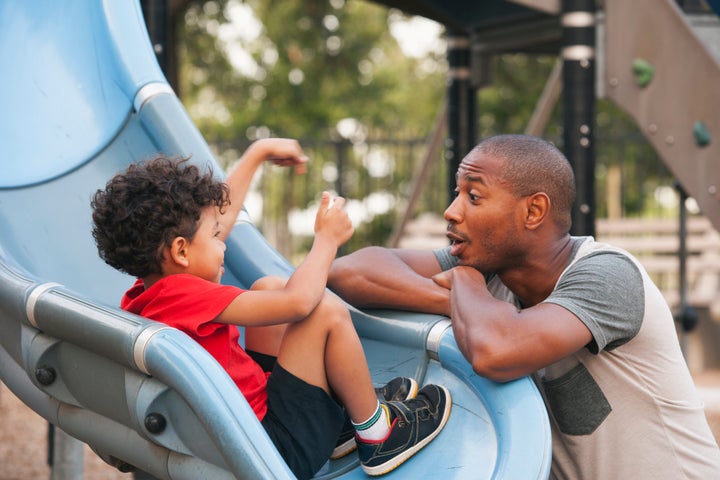
Words are powerful!
The way in which we choose to communicate with our children has a great influence on their development, including their sense of autonomy and independence. The words we speak to our children, the manner in which we listen and the respect we show them in responding to the words they speak to us has tremendous potential for shaping their self-confidence and communication abilities throughout their lives.
Little things parents do and say every day have a huge positive impact on children. Many caregivers display constructive behaviors while conversing with children of all ages that benefit the children’s development of independence and self-confidence. These behaviors may include:
Responsiveness. From the earliest interactions you have with your child as a newborn, she is learning and making connections in her brain. She notices when you are engaged and that you respond to her based on the cues she gives you.
The connections in her brain are further strengthened as you make eye contact, listen and respond to her words as you engage in two-way conversations when she acquires language. You are establishing a foundational relationship with your child through your communication with her right from the start. She is learning that she is of value to you and that her thoughts, feelings and words are important, thus building her confidence.
Being polite and respectful. Your child is a small person whose confidence and perception of himself and his place in the world is being shaped by his environment. When you are polite to him and respectful in listening to his thoughts, ideas and desires, he will feel listened to and appreciated. Respect and polite conversation is a two way street and he will follow your lead with regards to courteous communication.
When you consistently model turn taking in conversations and the use of polite phrases such as: “Please,” “Thank you,” “I’m sorry,” and “I forgive you,” and maintain the expectation that all family members also uphold the same level of considerate interaction with one another, you encourage mannerly discourse that builds confidence, respect and independence for future interactions with individuals outside the family.
Sharing your thought and decision-making processes. When you narrate or explain the thinking that goes into making a choice, you give your child an opportunity to learn by observing and hearing the weighing of pros and cons and to see reasoning in action. You are in charge of your children’s safety, security and well-being and thus you make many decisions on a daily basis that effect their lives.
Naturally a parent cannot reasonably give explanations for every decision made, nor is it necessary for children to be privy to all the details that go into adult’s decision-making processes, but it can be tremendously beneficial for children to hear about their parents’ reasoning and thought processes.
It can be as simple as, “When we take off our shoes, they must be put on the shelf so that no one will trip on them.” It can also be a more a more complicated scenario that simply models the step by step process an adult goes through, “I would like to make chocolate chip cookies later; let me look at my recipe, check the cupboards to see if I already have the ingredients, and then make a list of what I need to buy when I go to the store later.”
When your children observe and listen to you as you thoughtfully plan and makes decision, they learn about the process of considering alternatives, organizing thoughts and solving problems. As children grow older, they can also be included in some decision making by offering ideas, options and alternative suggestions.
Active Listening. It has been said that while listening, some people wait for the opportunity to respond while others wait to hear what the speaker is saying. Active listening involves whole body listening, including eye contact.
When we make eye contact with our children, they know that we are actually engaged and listening to what they are saying. However, sometimes, as children grow older, active listening involves listening without making eye contact due to the fact that children may feel intimidated and put on the spot when looked at.
Responsive parents learn to read the signs and participate in conversations that show the child that they are truly listening at times when eye contact is not required. Car rides are good for this kind of conversation, as well talking when the lights are dim at bedtime.
Most of all, active listening involves following the flow of conversation with give and take, listening and responding in kind.
Parents who both build confidence-enhancing techniques into their conversations with their children and excel at active listening display some of the following characteristics:
-They remain silent (while nodding or otherwise showing that they are listening) until the child is finished talking.
-They repeat back what the child has said, often in the form of a question in order to check for understanding
-They ask open ended questions that may not have a correct answer and ask follow-up questions to extend their children’s thinking.
-They incorporate choices into their questions by asking OR questions.
-They encourage problem solving by using phrases like,
“It sounds like you have a problem…”
“How are you going to solve that problem?”
“I wonder if….?”
“Have you ever thought about…?”
“What if….?”
The words we use and ways in which we listen and respond can be transformative for our children in shaping their views of themselves and their capabilities. If we want our children to have confidence and to exert independence and autonomy, we need to give them the opportunity to express themselves and their ideas in an environment in which they feel valued, nurtured and supported. How do you use your words and conversations to encourage your children to confidently share their thoughts and opinions?
This article was originally published on the author’s website, Nurturance.